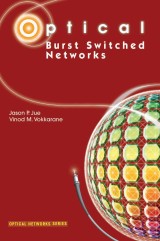Details

Optical Burst Switched Networks
Optical Networks
|
96,29 € |
|
| Verlag: | Springer |
| Format: | |
| Veröffentl.: | 07.06.2006 |
| ISBN/EAN: | 9780387237602 |
| Sprache: | englisch |
| Anzahl Seiten: | 147 |
Dieses eBook enthält ein Wasserzeichen.
Beschreibungen
<P>Next-generation high-speed Internet backbone networks will be required to support a broad range of emerging applications which may not only require significant bandwidth, but may also have strict quality of service (QoS) requirements. Furthermore, the traffic from such applications are expected to be highly bursty in nature. For such traffic, the allocation of static fixed-bandwidth circuits may lead to the over-provisioning of bandwidth resources in order to meet QoS requirements.</P>
<P>Optical burst switching (OBS) is a promising new technique which attempts to address the problem of efficiently allocating resources for bursty traffic. In OBS, incoming data is assembled into bursts at the edges of the network, and when the burst is ready to be sent, resources in the network are reserved only for the duration of the burst. The reservation of resources is typically made by an out-of-band one-way control message which precedes the burst by some offset time. By reserving resources only for the duration of the burst, a greater degree of utilization may be achieved in the network.</P>
<P>This book provides an overview of optical burst switching. Design and research issues involved in the development of OBS networks are discussed, and approaches to providing QoS in OBS networks are presented. Topics include:</P>
<P>- Optical burst switching node and network architectures</P>
<P>- Burst assembly</P>
<P>- Signaling protocols</P>
<P>- Contention resolution </P>
<P>- Burst scheduling</P>
<P>- Quality of service in OBS networks</P>
<P>Optical burst switching (OBS) is a promising new technique which attempts to address the problem of efficiently allocating resources for bursty traffic. In OBS, incoming data is assembled into bursts at the edges of the network, and when the burst is ready to be sent, resources in the network are reserved only for the duration of the burst. The reservation of resources is typically made by an out-of-band one-way control message which precedes the burst by some offset time. By reserving resources only for the duration of the burst, a greater degree of utilization may be achieved in the network.</P>
<P>This book provides an overview of optical burst switching. Design and research issues involved in the development of OBS networks are discussed, and approaches to providing QoS in OBS networks are presented. Topics include:</P>
<P>- Optical burst switching node and network architectures</P>
<P>- Burst assembly</P>
<P>- Signaling protocols</P>
<P>- Contention resolution </P>
<P>- Burst scheduling</P>
<P>- Quality of service in OBS networks</P>
Technology and Architecture.- Burst Assembly.- Signaling.- Contention Resolution.- Channel Scheduling.- Quality of Service.- Other Topics.
<P>Next-generation high-speed Internet backbone networks will be required to support a broad range of emerging applications which may not only require significant bandwidth, but may also have strict quality of service (QoS) requirements. Furthermore, the traffic from such applications are expected to be highly bursty in nature. For such traffic, the allocation of static fixed-bandwidth circuits may lead to the over-provisioning of bandwidth resources in order to meet QoS requirements.</P>
<P>Optical burst switching (OBS) is a promising new technique which attempts to address the problem of efficiently allocating resources for bursty traffic. In OBS, incoming data is assembled into bursts at the edges of the network, and when the burst is ready to be sent, resources in the network are reserved only for the duration of the burst. The reservation of resources is typically made by an out-of-band one-way control message which precedes the burst by some offset time. By reserving resources only for the duration of the burst, a greater degree of utilization may be achieved in the network.</P>
<P>This book provides an overview of optical burst switching. Design and research issues involved in the development of OBS networks are discussed, and approaches to providing QoS in OBS networks are presented. Topics include:</P>
<P>- Optical burst switching node and network architectures</P>
<P>- Burst assembly</P>
<P>- Signaling protocols</P>
<P>- Contention resolution </P>
<P>- Burst scheduling</P>
<P>- Quality of service in OBS networks</P>
<P>Optical burst switching (OBS) is a promising new technique which attempts to address the problem of efficiently allocating resources for bursty traffic. In OBS, incoming data is assembled into bursts at the edges of the network, and when the burst is ready to be sent, resources in the network are reserved only for the duration of the burst. The reservation of resources is typically made by an out-of-band one-way control message which precedes the burst by some offset time. By reserving resources only for the duration of the burst, a greater degree of utilization may be achieved in the network.</P>
<P>This book provides an overview of optical burst switching. Design and research issues involved in the development of OBS networks are discussed, and approaches to providing QoS in OBS networks are presented. Topics include:</P>
<P>- Optical burst switching node and network architectures</P>
<P>- Burst assembly</P>
<P>- Signaling protocols</P>
<P>- Contention resolution </P>
<P>- Burst scheduling</P>
<P>- Quality of service in OBS networks</P>
Covers optical burst switching and is highly used in the area of network quality of service Includes supplementary material: sn.pub/extras
<P>Optical Burst Switched Networks provides an overview of optical burst switching which is intensively used in the area of network quality of service. Design and research issues involved in the development of OBS networks are discussed, and approaches to providing QoS in OBS networks are presented. Topics include: optical burst switching node and network architectures; burst assembly; signaling protocols; contention resolution; burst scheduling; quality of service in OBS networks. The audience is industry practitioners, researchers, and graduate students who work on (and/or want to learn more about) optical WDM networks, and/or related fields.</P>
Diese Produkte könnten Sie auch interessieren:

Autonomic Communication

von: Athanasios V. Vasilakos, Manish Parashar, Stamatis Karnouskos, Witold Pedrycz

149,79 €















